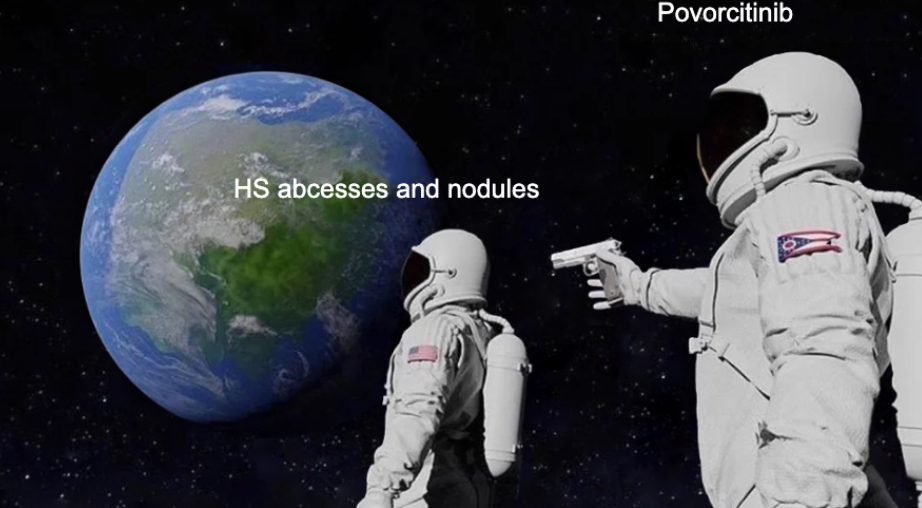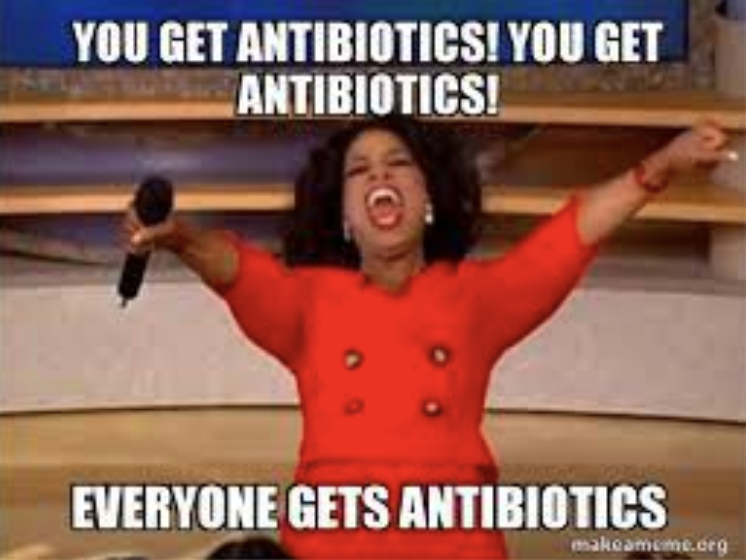Fifty-fourth issue
February 21, 2024
Does the addition of oral acitretin to topical triamcinolone for oral lichen planus improve outcomes?
JAMA Dermatology
JAMA Dermatology
As if we needed another reason to love our Vitamin A derivatives…
Oral lichen planus (OLP) is a painful inflammatory mucosal disease that causes ulcerative lesions in the mouth, may be associated with cutaneous lichen planus (LP), and is often difficult to treat.
This monocentric, placebo-controlled, double-blinded randomized clinical trial (RCT) involving 64 patients with symptomatic (defined as pain and burning and overall decrease in quality of life) OLP compared the efficacy of oral acitretin plus topical triamcinolone acetonide (TAC) 0.1% to TAC alone in patients with symptomatic OLP. Response to treatment was assessed using the Oral Disease Severity Score (ODSS) at 28 and 36 weeks.
What did they find?
Limitations: Pre-menopausal women were excluded from the study. The adverse effects of acitretin could have potentially unblinded the oral acitretin + topical TAC group, introducing bias.
Main Takeaway: The combination of oral acitretin + topical TAC was more effective in treating symptomatic OLP than topical TAC monotherapy.
Oral lichen planus (OLP) is a painful inflammatory mucosal disease that causes ulcerative lesions in the mouth, may be associated with cutaneous lichen planus (LP), and is often difficult to treat.
This monocentric, placebo-controlled, double-blinded randomized clinical trial (RCT) involving 64 patients with symptomatic (defined as pain and burning and overall decrease in quality of life) OLP compared the efficacy of oral acitretin plus topical triamcinolone acetonide (TAC) 0.1% to TAC alone in patients with symptomatic OLP. Response to treatment was assessed using the Oral Disease Severity Score (ODSS) at 28 and 36 weeks.
What did they find?
- 84% of patients in the oral acitretin + topical TAC group achieved 75% reduction in ODSS at 28 weeks (88% vs 47%P < .001 and 36 weeks (84%vs 41% P < .001)
- 41% of patients receiving placebo + topical TAC (TAC alone) achieved 75% reduction in ODSS
- Relapse of disease during post-treatment follow up at 8 weeks was low in both groups (3% vs 6%, a P > .99)
Limitations: Pre-menopausal women were excluded from the study. The adverse effects of acitretin could have potentially unblinded the oral acitretin + topical TAC group, introducing bias.
Main Takeaway: The combination of oral acitretin + topical TAC was more effective in treating symptomatic OLP than topical TAC monotherapy.
Efficacy and safety of the oral Janus kinase 1 inhibitor povorcitinib in patients with hidradenitis suppurativa in a phase 2 RCT
Journal of American Academy Dermatology
Journal of American Academy Dermatology
JAKing up hope for HS treatment with povorcitinib!
Hidradenitis suppurativa (HS) is a chronic inflammatory skin condition characterized by painful skin nodules and abscesses, often resulting in draining tunnels, tissue damage, and scarring. It is difficult to treat; while current treatment options include topical/oral antibiotics or biologics such as adalimumab, there is a need for new efficacious treatments for HS.
This phase 2, randomized, double-blind, dose-ranging, placebo-controlled study (n=209) examined the efficacy and safety of povorcitinib in treating HS at doses of 15mg, 45mg, and 75mg over 16 weeks. The primary and key secondary endpoints were the mean change from baseline in abscess and inflammatory nodule count (AN) and the percentage of patients achieving HS clinical response at week 16, respectively.
What did they find?
Main Takeaway: Povorcitinib reduced abscess, inflammatory nodule, and draining tunnel counts over 16 weeks without evidence of an increased incidence of adverse events compared to placebo.
Hidradenitis suppurativa (HS) is a chronic inflammatory skin condition characterized by painful skin nodules and abscesses, often resulting in draining tunnels, tissue damage, and scarring. It is difficult to treat; while current treatment options include topical/oral antibiotics or biologics such as adalimumab, there is a need for new efficacious treatments for HS.
This phase 2, randomized, double-blind, dose-ranging, placebo-controlled study (n=209) examined the efficacy and safety of povorcitinib in treating HS at doses of 15mg, 45mg, and 75mg over 16 weeks. The primary and key secondary endpoints were the mean change from baseline in abscess and inflammatory nodule count (AN) and the percentage of patients achieving HS clinical response at week 16, respectively.
What did they find?
- At week 16, the mean change from baseline in AN was -5.2 -6.9, and -6.3 for povorcitinib at 15mg, 45mg, and 75 mg, respectively, versus -2.5 for placebo (15mg, p = 0.0277; 45mg, p = 0.0006; 75mg, p = 0.0021)
- At week 16, the mean change from baseline in draining tunnel counts was +0.1, -0.8, and -1.1 for povorcitinib 15mg, 45mg, and 75mg, respectively, versus -0.3 for placebo
- More patients treated with povorcitinib achieved HS Clinical Response at week 16 versus placebo (15mg, 48.1%, p = 0.0445; 45mg, 44.2%, p = 0.0998; 75mg, 45.3%, p = 0.0829)
- Treatment-related treatment-emergent adverse events (TEAE) occurred in 21.3% of patients receiving any povorcitinib dose (15mg, 17.3%; 45mg, 24.0%; 75mg, 22.6%)
Main Takeaway: Povorcitinib reduced abscess, inflammatory nodule, and draining tunnel counts over 16 weeks without evidence of an increased incidence of adverse events compared to placebo.
Are pediatric patients with IBD predisposed to specific dermatologic conditions?
Pediatric Dermatology
Pediatric Dermatology
Irritable bowel disease: A real pain in the gut… and the skin!
Inflammatory bowel disease (IBD) poses a significant healthcare burden among pediatric patients. Dermatologic manifestations are common in IBD patients of all ages, yet data regarding these conditions in pediatric populations remain limited. Previous studies categorized dermatologic manifestations into IBD-specific (e.g., perianal, orofacial) and nonspecific (e.g., reactive, malabsorption-related) lesions, but the prevalence in childhood IBD and its relation to disease severity remains unclear.
Additionally, patients undergoing immunosuppressant and anti-TNF-α medication treatment for IBD are anticipated to have a heightened risk of bacterial, viral, fungal, and opportunistic skin infections. This retrospective review of 425 pediatric patients (aged 0 to 18) with IBD investigated the prevalence of dermatologic diagnoses and their association with the disease severity among children with IBD.
What did they find?
Inflammatory bowel disease (IBD) poses a significant healthcare burden among pediatric patients. Dermatologic manifestations are common in IBD patients of all ages, yet data regarding these conditions in pediatric populations remain limited. Previous studies categorized dermatologic manifestations into IBD-specific (e.g., perianal, orofacial) and nonspecific (e.g., reactive, malabsorption-related) lesions, but the prevalence in childhood IBD and its relation to disease severity remains unclear.
Additionally, patients undergoing immunosuppressant and anti-TNF-α medication treatment for IBD are anticipated to have a heightened risk of bacterial, viral, fungal, and opportunistic skin infections. This retrospective review of 425 pediatric patients (aged 0 to 18) with IBD investigated the prevalence of dermatologic diagnoses and their association with the disease severity among children with IBD.
What did they find?
- 425 pediatric patients with IBD were included in the study, consisting of 64.9% with Crohn’s disease (CD) and 35.1% with ulcerative colitis (UC), and with a gender disparity favoring males in CD and females in UC
- For patients with IBD:
- 42.8% of pediatric IBD patients experienced at least one cutaneous infection
- The most prevalent non-infectious dermatologic diagnoses were:
- Acne vulgaris (30.8%)
- atopic dermatitis (15.8%)
- perianal skin tags (14.6%)
- CD patients were more likely than UC patients to be diagnosed with angular cheilitis (7.2% vs 2.0%), perianal skin complications (20.3% vs 4.0%), and keratosis pilaris (6.9% vs 0.7%)
- UC patients were more likely than CD patients to be diagnosed with fungal skin infections (15.4% vs 8.0%) and certain viral skin infections (12.1% vs 6.9%)
- Treatment with certain medications was linked to different cutaneous infections, with budesonide associated with higher non-impetigo bacterial infections (42.4% vs 17.3%) and methotrexate correlated with increased impetigo prevalence (25.0% vs 4.3%)
- Increasing severity of IBD was associated with a higher prevalence of certain dermatologic conditions, particularly in CD patients, while psoriasis was the only condition significantly correlated with severe UC phenotypes
Intravenous gentamicin therapy induces functional type VII collagen in recessive dystrophic epidermolysis bullosa patients: An open label clinical trial
British Journal of Dermatology
British Journal of Dermatology
What can’t antibiotics do these days?
Recessive dystrophic epidermolysis bullosa (RDEB) is a widespread blistering disorder caused by nonsense mutations in the gene that encodes for type VII collagen. Currently, there are no curative treatments for RDEB and available therapies are focused on supportive care. In vitro and early in vivo studies suggest that gentamicin may improve wound healing in RDEB through induction of collagen VII production.
In this study, the authors sought to investigate whether systemic administration of gentamicin may benefit wound closure in patients with RDEB. They administered IV gentamicin for 14 days consecutively to 3 patients, and 2/3 patients received additional IV gentamicin twice weekly for a total of 12 weeks.
What did they find?
-IV gentamycin significantly increased production of collagen VII, as visualized in skin biopsies post-treatment
-The new collagen VII persisted for at least 6 months after treatment
-Administration of IV gentamycin improved wound closure at 1 month and 3 months post-treatment
-In this study, no significant ototoxicity or nephrotoxicity were observed in response to IV gentamicin
Main takeaway: IV gentamicin restored production of functional collagen VII in the skin of patients with RDEB.
Recessive dystrophic epidermolysis bullosa (RDEB) is a widespread blistering disorder caused by nonsense mutations in the gene that encodes for type VII collagen. Currently, there are no curative treatments for RDEB and available therapies are focused on supportive care. In vitro and early in vivo studies suggest that gentamicin may improve wound healing in RDEB through induction of collagen VII production.
In this study, the authors sought to investigate whether systemic administration of gentamicin may benefit wound closure in patients with RDEB. They administered IV gentamicin for 14 days consecutively to 3 patients, and 2/3 patients received additional IV gentamicin twice weekly for a total of 12 weeks.
What did they find?
-IV gentamycin significantly increased production of collagen VII, as visualized in skin biopsies post-treatment
-The new collagen VII persisted for at least 6 months after treatment
-Administration of IV gentamycin improved wound closure at 1 month and 3 months post-treatment
-In this study, no significant ototoxicity or nephrotoxicity were observed in response to IV gentamicin
Main takeaway: IV gentamicin restored production of functional collagen VII in the skin of patients with RDEB.
Dermatophytes, the leading culprit causing superficial fungal infections (SFIs), have recently started to exhibit resistance to commonly utilized antifungals. The increase in incidence of SFIs combined with the emergence of antifungal resistance represents both a major global health and economic challenge.
For this review article, we analyzed the literature to examine the recent trends in dermatophyte infections from both an epidemiological and a clinical perspective. Focusing on tinea infections, we examined the current limitations and failures of standard antifungal treatments, the emergence of drug-resistant dermatophytes including several trichophyton species, and the diagnostic challenges faced by clinicians in diagnosing and treating these conditions. We highlighted the importance of antifungal susceptibility testing and molecular diagnostic methods, and proposed the following pharmacological and non-pharmacological treatments:
- Efinaconazole topical 10% solution
- Luliconazole topical 1% cream
- Tavaborole topical 5% solution
- Yttrium Aluminum Garnet (Nd:YAG) laser therapy
Moving forward, this growing trend of antifungal resistance must be addressed through innovative research with the development of new treatments. In the clinical setting, providers must be aware of the various dermatophyte organisms that cause tinea infections and which strains are becoming resistant in order to adequately diagnose and treat these infections.
For this review article, we analyzed the literature to examine the recent trends in dermatophyte infections from both an epidemiological and a clinical perspective. Focusing on tinea infections, we examined the current limitations and failures of standard antifungal treatments, the emergence of drug-resistant dermatophytes including several trichophyton species, and the diagnostic challenges faced by clinicians in diagnosing and treating these conditions. We highlighted the importance of antifungal susceptibility testing and molecular diagnostic methods, and proposed the following pharmacological and non-pharmacological treatments:
- Efinaconazole topical 10% solution
- Luliconazole topical 1% cream
- Tavaborole topical 5% solution
- Yttrium Aluminum Garnet (Nd:YAG) laser therapy
Moving forward, this growing trend of antifungal resistance must be addressed through innovative research with the development of new treatments. In the clinical setting, providers must be aware of the various dermatophyte organisms that cause tinea infections and which strains are becoming resistant in order to adequately diagnose and treat these infections.





